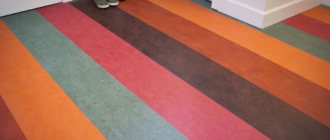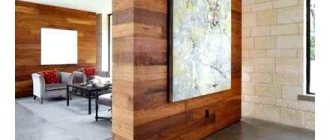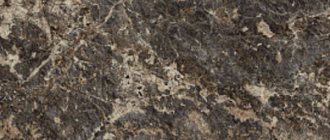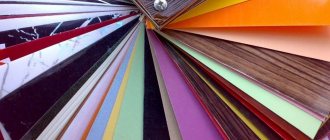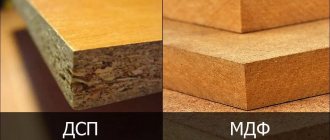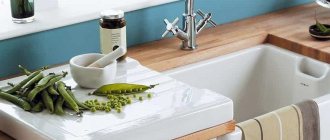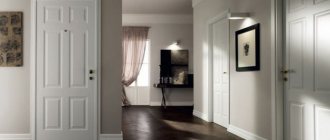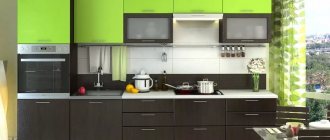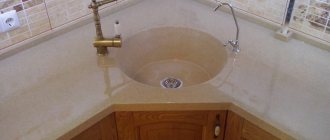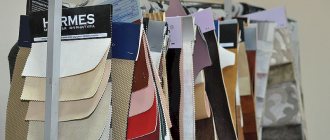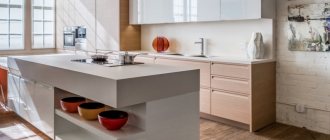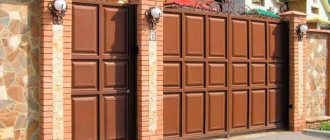MDF is the initial letters of the English expression Medium Density Fiberboard. The technology that is now used in the production of MDF is a refinement and improvement of the technology that was used for the production of fiberboard - fiberboard, made from the smallest fractions of sawdust. In the production of MDF, wood fibers are dried, bonded and formed into a board, which is treated with high pressure and high temperature. Paraffin and lignin are used as fastening elements. Lignin is a natural substance found in every tree. Lignin is obtained from wood by treating it at high temperatures. No harmful resins or phenol are used in the production of MDF. Based on the above, we can safely say that MDF is an environmentally friendly material. Among the main advantages of MDF are: - a sufficient level of softness, thanks to which MDF lends itself very easily to the finest processing, which makes it a favorite material for furniture makers and designers, as it allows the most daring decisions to be realized. Despite the fact that MDF is used in many industries, MDF is mainly used as a furniture material. - despite the fact that MDF has adopted all the advantages of wood, it costs several times less. — the service life of products made from MDF is many times longer than the service life of products made from solid wood.
One of the disadvantages of furniture MDF is the lack of production of this material in our country.
As already mentioned, MDF is used in many areas, but in the furniture industry it is used especially actively and there are many reasons for this. In the production of furniture, mainly solid wood, fiberboard (fibreboard) and chipboard (chipboard) are used. All these materials are practically unsuitable for painting.
Wood is an excellent natural material, it can easily be processed through the finest treatments, but it does not tolerate moisture, it dries out and cracks. Under varnish, cracks in the wood are not noticeable, but under paint, especially light paint, they will immediately catch your eye.
Particle boards (chipboards) are a fairly strong material, excellent for painting, but cannot withstand moisture and cannot be milled. Wood fiber boards (Fiberboard) are a very thin material, they are processed with great difficulty, do not tolerate moisture, and cannot be painted evenly.
Furniture MDF lends itself perfectly to the finest processing, milling and sanding. Furniture MDF can be perfectly painted. Finished products made from MDF furniture do not warp, crack or dry out. MDF, having all the positive qualities of wood, is completely devoid of the disadvantages that are inherent in wood: low density, heterogeneity, the presence of knots, and a tendency to rot. In the production of MDF boards, adhesives containing formaldehyde are not used, therefore furniture made from MDF has received permission for use in children's institutions, hospitals and in those premises that require a high degree of protection from the external environment. Furniture MDF is a universal material, therefore it is widely used for the manufacture of furniture for offices and for the home; doors, countertops, window sills, floors, baseboards, suspended ceilings, packaging, containers, toys for children, school supplies and much, much more are made from it.
Separately, it should be said about the advantages of MDF furniture, which make it an indispensable material for the manufacture of furniture for the kitchen and bathroom. In addition to the fact that MDF is not afraid of moisture and steam, does not crack or change shape, mold and mildew do not form on it, the structure of MDF boards allows you to cut beautiful rounded corners.
Furniture MDF is often covered with a polyvinyl chloride film, the resulting material is called laminated MDF. PVC film will allow MDF boards to reproduce any color and shade, right down to the wood structure. Laminated MDF is slightly more expensive. It is worth noting that furniture facades made from pine or beech oak cost sixty percent more than facades made from laminated MDF. And this despite the fact that constant exposure of wood to moisture renders it unusable, and laminated MDF is not susceptible to its effects, so it will last for quite a long time.
MDF for flooring - pros and cons
The wood-based material MDF can be processed as easily and simply as natural wood.
But despite all these properties, it is superior to natural material in almost everything, because it is devoid of heterogeneity of structure. It also provides worthy competition to plywood, the “founder” of wood sheet materials, because it is the most dense and does not warp under the influence of external irritants. Due to the huge number of advantages, MDF is often used in the construction industry, for the production of furniture and as a finishing material for renovation work, not excluding flooring.
Production technology
Modern production makes it possible to create an almost identical copy of the natural structure of wood.
The finely dispersed fraction of wood has its own operating characteristics, due to which it has many advantages.
But let's start with the stages of MDF production:
- Preparation
. The logs are cleared of bark, crushed into chips and sorted, clearing them of debris and dirt. Heat by steam. - Formation of fibers.
The resulting chips are crushed as much as possible in a special machine - a refiner. This is necessary to release the natural resin from MDF - lingin, which will later act as glue. - Formation of the slab.
The prepared mass is sent to the machine, where it is laid in the form of a sheet using rollers. This is where pre-compression occurs. - Pressing.
At this stage, the chips finally take on their future shape. After pressing, the material must cool for half an hour. The unsanded sheet is then processed until smooth.
Technical features
The density of MDF is 1100 kg/m3, which makes it possible to obtain different profiles that are comfortable to process and convenient for future use. In terms of their features, wood-based panels, which are used for laying pre-flooring, are superior to certain characteristics of ordinary plywood and natural wood:
- withstands the effects of sunlight;
- are not affected by low temperatures;
- just transported.
The small thickness variation allows us to guarantee a very even surface of the floor covering and no warping. If for plywood the warping coefficient is 15 mm/1 m diagonal, then for MDF it does not exceed 1.2 mm. Such precision in the manufacture of this material, without impressive differences between the size and width of the sheet, is achieved thanks to the formed MDF carpet, in comparison with plywood sheets, which are made from veneer and, accordingly, do not have such technical features.
If we compare the characteristics of the differences in thickness, length and width, we have the following picture:
- for MDF the deviation in thickness is 0.2 mm, and for plywood it is from 0.5 to 2.5 mm.
- width and length characteristics are 2 and 5 mm, respectively.
Separately, it is necessary to note the aspect of hardness and abrasion resistance of the panel. So, this wood panel sheet has a very high hardness level - 10-11 kg/mm 2. Whereas for almost all natural wood species the same indicator is much lower:
- oak – 6.9;
- beech – 7.2;
- birch – 4.9.
The remaining characteristics that are important at the stage of laying the preliminary floor are identical for plywood and MDF.
Areas of application of LMDF
Thanks to an impressive set of advantages, laminated MDF boards are used in production:
1). Furniture for various purposes and designs: kitchen, office, cabinet, children's, decorative, commercial, etc. Mostly laminated MDF sheets with a thickness of 10-22 mm are used.
MDF linen closet
Factory products are characterized by smooth lines, non-traumatic, reliable, durable and safe for the health of others. The edges are always finished with either edge strips or an additional layer of laminating film.
2). "Semi-finished products." This is the so-called furniture panel - a LMDF board with a thickness of 8 mm, 10 mm, 12-22 mm, which is cut on machines or manually into parts, then furniture is assembled from them.
Laminated furniture board is most in demand among private and home craftsmen, as it allows you to work according to individual sketches and sizes.
3). Molded products for commercial and private use: countertops, window sills. They are used to make tables for offices, salons, bars, restaurants, kitchen worktops, and window frames. The thickness of the sheets used varies from 10 to 40 mm.
4). Trade and exhibition equipment, advertising signs for external walls, etc.
5). Finishing materials.
MDF panels in the living room interior
Sheets with a thickness of 3-6, 8, 10, 12-18 mm are used. In assortment:
- Panels for walls and ceilings indoors, as well as components for them (corners, moldings and other accessories);
- Skirting boards and cornices;
- Platbands, strips and other decorative and protective elements for walls, ceiling structures (beams, balusters, columns, arched devices);
- Facing panels for steel entrance and interior doors (3-10 mm).
Of particular interest from all the variety is the façade furniture panel made from LMDF. Due to the properties of the material, it can be used to form, for example, bent doors for corner cabinets or figuratively cut tabletops, aprons for walls.
The edges of the part will remain smooth, without chips or defects. If a furniture panel made of chipboard is used, then similar processing quality is very difficult to achieve, except perhaps only on professional high-precision machines.
We will separately focus on such products as panels for walls and ceilings. The average thickness of products is 4-10 mm, the width of products varies from 10 cm to 3 m, and the length reaches 3 m.
The ends, as a rule, have a tongue-and-groove connection system, which greatly facilitates and speeds up installation. Manufacturers offer several types of products:
- Panels with a seam (analogue of lining);
- Seamless products (joint to joint);
- Aprons for kitchen sets;
- Large-format panels for walls under tiles without connecting ridges (glued to the base without gaps).
Window sills and tabletops as molded products are produced in strips of 10-50 m, which are subsequently cut to specified sizes. In demand among manufacturers of furniture and window products. They are also used for finishing slopes.
MDF sheets (furniture panels, facades, window sills) are sold by wholesale warehouses of building materials or specialized dealer companies. Panels for walls and ceilings, baseboards, cornices, and cladding can be purchased at any construction store or market.
When purchasing, you should be guided not by price, but by the availability of certificates and visual inspection of product quality. The surface should be free of blisters, scratches, peeling, wet spots and other defects, as they are classified as non-repairable.
More details in the video below:
Source: otdelkadom-surgut.ru
Advantages of individuality over other materials
Milling
Not all wood-based materials can be milled, but with MDF such difficulties do not arise; the most complex patterns and profiles can be created on its surface.
Coloring
The surface of the panel can be painted and laminated, so you can get the material in any color. When painting, preference is given to polyurethane paints.
Environmental friendliness
After natural wood, MDF is one of the first in the list of materials that can be compromised by their environmental friendliness. In the manufacture of panels, lignin and other additives are used as a binder, which ensure a low level of formaldehyde emission. This aspect is one of the necessary ones when choosing wood-based materials for buyers.
Strength and shape change
Thanks to the binding substances, the strength of this material is also ensured, which is twice as strong as other wood boards. It should also be noted that although the material has the highest strength, at the same time it can simply be changed in shape. This is achieved thanks to the frequency of milled grooves, the material is suitable for the production of bent parts.
Ease of processing
The advantages of MDF also include its superior manufacturability. This indicator means ordinary material in processing. From the panels you can very quickly make different profiles, multiple moldings and rounded corners. This significantly expands the scope of implementation of slabs at the stage of product design or when developing the future design of the room.
Physical and mechanical characteristics
MDF boards can be laid on the floor, because their properties are similar to natural wood, but the advantage of this material is that it is cheaper. As a laying material for floors or wall panels, wood board material is also selected for a number of other characteristics:
- the highest level of noise absorption;
- resistance to temperature changes;
- maintaining shape at high humidity;
- completely smooth surface of the panel.
You can also lay a floor with MDF without the risk of fungi and various pathogens - the material is highly hygienic and therefore not dangerous for use for domestic purposes.
Having not found a single disadvantage in using MDF as a finishing material, we can summarize - these are panels of the highest degree of reliability, with a wide scope of application and low price, which are not inferior in their abilities to natural wood.
- About company
- Price list
- Payment (issue of money for any obligation)
and delivery - Articles
- Contacts
Comparison of characteristics
To choose the most suitable option for rough or fine finishing of a floor structure, it is necessary to take into account the main parameters of the product.
Environmental friendliness
Health safety is one of the main factors. The indicators of wood-based panel materials comply with the standards reflected in standardization documents.
- Plywood. Eco-friendly option. The most harmless products are those that are glued using natural resins.
Since the outside of all materials is finished, harmful fumes are minimized.
On a note! To completely protect yourself from harmful effects, when purchasing, you should check for certificates of conformity.
Strength
To choose the most reliable option, you need to take into account the density and structure of the product:
- OSB and plywood. Oriented strand panels can withstand heavy loads well: the layers are placed in different directions and glued together extremely firmly. But wood-laminated board may have a significant disadvantage - the possibility of deformation due to non-compliance with the technology.
It is difficult to compare all products on this parameter, since they have different sizes.
Dimensions
The length and width of all varieties are approximately the same, so it is necessary to compare the thickness:
- Hardboard. The thinnest material. Its thickness can reach up to 7 mm, but the most common is 3.2 mm.
- Plywood. For the floor, products with a thickness of 12–15 mm are selected.
The thickness and structure of the parts also affects protection from sound penetration and heat retention. If the noise pollution is very strong, then it is recommended to give preference to medium-density fiberboards of maximum thickness. They also serve as additional thermal insulation, which is similar to OSB.
Price
The difference in the price of materials depends on many factors: production method, raw materials used, additional processing, size and even place of sale.
- The most expensive is high-grade plywood.
- The cost of MDF is calculated per square meter and depends on the manufacturing method.
- The price of OSB-3 and 2 corresponds to wood-laminated boards of grade 3 or 2 of a smaller size.
To ensure that the total work budget does not amount to too significant an amount, it is necessary to immediately determine the scope of application of each type of product.
Easy to install
Laying wood boards is not difficult; it does not require professional skills or complex tools. The order of work depends on the specific situation:
- If a frame structure is being erected, then OSB would be the best option.
- The light weight and thickness of hardboard make processing the fastest, but it is not suitable for serious leveling.
- Chipboard and OSB panels are cut and fixed almost identically. They are much easier to trim than MDF, which due to its dense structure offers more resistance.
- The most labor-intensive material to process is plywood. It will take much longer to place the product. It is more difficult to drill or adjust to size due to the presence of layers of natural wood in the structure.
What material is better for the floor?
To select the most suitable option, the specifics of the room and the final coating are taken into account:
- Under the tiles in the bathroom you can use chipboard and OSB, but only varieties with moisture-resistant impregnation. If you place products without treatment, there is a high probability of mold and mildew. This also applies to the decoration of the kitchen, hallway and balcony.
Thus, it is impossible to single out any one material. To obtain better results and increase the service life of the coating, it is preferable to combine products.
Types of MDF skirting boards
The profile is made from compressed wood chips, and the products differ in appearance and coating:
For painting (L-Decor, Smartprofile Paint, Tarkett) - these are snow-white skirting boards that can be painted in any color. Snow-white skirting boards, also colored to match the walls, are especially vital.
Veneered - have a final coating of a printed film that imitates wood. They are often produced in a similar design to laminate (Tarkett, Quick Step). Installation on a mounting plate, special clips or glue.
3. Polymer coated (Deartio). Usually these are snow-white profiles, but there are also colored, grayish, and dark ones. They are immediately ready for installation and do not require painting. The coating is strong and wear-resistant, withstands water and washing well.
Paintable MDF skirting boards also come in different types according to external treatment: smooth without primer, textured, primed. It is recommended to paint products with acrylate or alkyd paints on an aqua base.
You can purchase connecting elements from almost all brands that allow you to aesthetically design the corners and joints of the plinth during installation.
Which MDF plinth to choose
MDF profiles fit perfectly into a wide variety of interiors. For traditional ones there are openwork profiles, for modern ones there are straight ones. The choice of color should be based on personal preferences and combination with the decoration of the room.
For laminate, parquet boards and other wood-like floors, a veneered baseboard in a similar or similar design is suitable. For colored or pastel walls, you can purchase a baseboard for painting and give it the same color as the walls. A trivial plus is that the color scheme can be chosen very literally.
Snow-white plinth looks unsurpassed in any interior. The main thing is to choose the appropriate profile shape.
Manufacturers
The first plant that began supplying MDF sheets to the domestic market was Sheksninsky KDP. It still works.
Now it withstands great competition from the following companies:
- Plitspichprom;
- Kronostar;
- Lesplitinvest;
- Russian laminate.
How to install?
Naturally, almost everyone is interested in whether it is possible to install an MDF plinth with your own hands in order to save on professional services. Yes, it is completely real and not difficult, especially since there are three possible methods:
With completely even walls, the installation process is the easiest - hidden fasteners on the mounting strip. The plank is screwed to the wall, and the MDF profile itself is inserted into it.
Assembly adhesive that firmly fixes skirting boards when the walls are cleaned.
Screws - fasteners for uneven walls. The plinth itself is screwed to the wall with screws and is pulled together without a gap. Additional work - the screw-in areas must be puttied, and after the putty has dried, painted in a suitable color. This method will be needed for skirting boards for painting.
Couldn't find the right skirting board in the catalog? Contact our professional in the website chat or by phone +7 (495) 514-56-67
The author of the article is Evgeniy Viktorovich Bridsky, an expert on flooring, skirting boards, cork
MDF panels: composition, dimensions, pros and cons, installation features
In the design of modern homes and office spaces, preference is given to natural materials. But the cost of wood from time to time is beyond the means of real estate owners.
Analogues help out the situation; they are not inferior to natural raw materials, and from time to time even superior to them in properties and features. One of these products is MDF.
Slab material made from fine wood shavings is often used in finishing work and in the manufacture of furniture.
Choice for the bedroom
For such a room it remains a very important accessory. For this reason, choosing the material from which it will be made is a very important process.
Today, very often people order bedroom furniture from chipboard or MDF, but still do not understand which is better. First, let's look at chipboard. The presented product is obtained from shavings, which are then treated with a binding component, namely formaldehyde resins.
DPS today are very relevant in the manufacture of cabinet furniture, or rather bedroom sets. The main advantages of chipboard material can be considered: easy processing, strength, excellent water resistance, the material perfectly and firmly holds all fasteners and is not expensive.
You can see what a kitchen countertop made of chipboard looks like in this article.
Chipboard is very often used in the production of economy class furniture. In this case, furniture sets are often installed in offices. However, for those who do not have a lot of money, they can also try installing a chipboard product in their bedroom.
However, the presented material has one significant drawback: when formaldehyde resins evaporate, a negative effect on human health occurs. In addition, there is a specific type of chipboard that is prohibited for use in the manufacture of bedroom furniture.
You can find out what the thickness of laminated chipboard is from this article.
Now you can move on to MDF. The presented product is characterized by a slab, the production process of which takes place from sawdust. Their fastening is carried out using paraffin and lignin. Compared to chipboard, this material is environmentally friendly, therefore it is very widely used in the manufacture of bedroom furniture.
The main advantages of MDF can be considered:
- environmental friendliness;
- minimal thickness, making it easy to process;
- has all the benefits of wood.
Compound
MDF contains only natural ingredients:
— crushed wood fraction;
- lignin, natural glue.
The creation of slab material involves a complex processing process. The grinding and compaction stages are carried out using the highest pressure. A significant temperature regime during pressing ensures a strong connection between wood chips and lignin, as a result of which the board acquires a solid structure.
The difficult production process did not deprive the MDF material of its wood properties, and even surpassed some of them. The density of natural wood is lower than that of a compressed panel.
Pros of MDF
• natural raw materials make the material environmentally friendly;
• density characteristics are higher than those of wood;
• aesthetic design of slabs, choice of textures;
• is not afraid of temperature changes;
• moisture-resistant properties allow wet cleaning during operation;
• versatility in application;
• slabs are easy to process;
There are also disadvantages of MDF panels that should be taken into account when working with the material:
• MDF burns well;
• weak resistance to mechanical damage and water.
Application areas and sizes of wood material
MDF is produced in 3 size categories:
Category 1: thin-walled slabs with a length of 1300-2800 mm, a width of 153-2070 mm, a width of 5-9 mm.
Category 2: medium wall slabs with a length of 2620-2800 mm, a width of 2070 mm, a width of 10-18 mm.
Category 3: thick-walled slabs with a length of 2620-2800 mm, a width of 2070 mm, a width of 19-30 mm.
Manufacturers have expanded the size range to optimally select the right material and reduce waste after installation work.
Dimensions do not have any effect on the properties of products. If necessary, you can order personal sizes in the range of 150-4000 mm.
Methods for processing the front side of panels
— gluing a narrow layer of veneer that imitates natural wood in color and texture;
— surface lamination with high-quality film;
— by painting with special paint (the latest technologies make it possible to achieve the effect of mother-of-pearl, matte or glossy surface);
— 3D effect imitating natural materials (leather, silk, granite, wood).
When decorating residential premises, MDF panels are used for finishing:
— loggias and balconies;
- utility rooms and dressing rooms;
- partial covering of the walls of the room using separation techniques.
Features of LMFD
MDF boards undergo a lamination process not only to protect the surface from scratches, water and other negative factors. The main purpose is decorative.
Learn more about how and where MDF panels are used in the following video:
Modern high-precision laser printing technologies make it possible to create any image with a perfectly executed depiction of any detail. For example, this could be the texture of wood, the pores of brick, etc.
All this allows you to get a pattern on the MDF surface that imitates the color and structure of natural wood, natural stone, porcelain stoneware or tiles, textiles, leather, metal and much more.
Various effects and techniques are used: aging, matting, patination, rustication, brushing, etching, etc.
Each manufacturer (Kronostar, Kronospan, Egger, KZMDF, etc.) develops its own line of designs, including:
- traditional wood decors (beech, oak, cherry, walnut);
- certain exotic wood species (jatoba, zebrawood, kempas, panga-panga);
- imitation stone surface (tiles, marble, limestone, granite, concrete);
- monochrome pastel, less often bright colors (vanilla, orange, saffron);
- metallized decors;
- non-standard (abstract combinations of shades, geometric shapes, thematic designs).
Thus, LMDF has a presentable appearance and a leading number of decors. Every year the range is replenished with new designs.
Individual installation of MDF panels
• To perform finishing work, two methods are used: fastening to a base and gluing to a flat surface. The first method is preferable, because insulation can be fixed under the finishing and the reliability of the structure will be higher than with gluing.
In addition, you can lay wiring behind the panels, making it hidden. Wood slats or iron profiles are used as the base material. The choice is made based on the humidity characteristics of the room. If the air humidity is high or average, then it is better to use profiles. Moistened slats can lead, then the whole system will become distorted.
• The corners under the panels must be used in color so as not to disturb the color harmony.
• If the finishing is done in a small room, then it is better to use light colors to visually enhance the space.
• In order for the panels to lie close to the profile, the starting chamfer should be removed.
• When mounting panels vertically, the base must match the type of installation, in other words, it must be installed vertically.
• The introduction of gluers for fastening panels will make it possible to carefully dismantle the finishing material and reinstall it.
• It is not recommended to cover bathrooms and kitchens with MDF panels. Constant humidity can have a negative impact on wood material.
• When selecting panels or transporting them to the installation space, special attention must be paid to the safety of the edges (locking part).
MDF panels - the main pros and cons
Any person who plans to carry out renovations in their own home is interested in using high-quality and non-hazardous building materials. MDF panels created for finishing walls and ceilings are especially popular.
Modern MDF panels are a worthy replacement for wood panels, but at the same time they are made from wood dust or shavings using the pressing method. Before making a final decision, it is important to carefully familiarize yourself with all the advantages and disadvantages of the finishing material, because only a responsible approach will allow you to successfully implement existing plans and ideas.
So, what can you still focus on when choosing and using MDF panels?
Advantages of MDF panels
Modern MDF panels, which are produced taking into account all working standards, have the necessary advantages:
- The building material is environmentally friendly . In its production, it is customary to use the dry pressing technique with the addition of lignin, which is also a natural raw material. For this reason, MDF panels can be used for interior decoration of residential premises without undue fear.
- Installation work with this building material constantly amazes with its simplicity and ease . Laying the panels is carried out using the designer’s method, so the performers do not have to have any special knowledge or skills. Often, in order to install MDF panels, you just need to use construction devices. As a result, repair activities will be completed promptly.
- MDF panels allow you to create virtually any design . This is justified by the fact that they can be easily sawed and cut to the best shape.
- Any person can choose specifically those MDF panels that he likes in color and shade. Moreover, manufacturers can imitate natural materials, including wood, granite, brick, and granite. In addition, modern technologies make it possible to imitate even leather.
- MDF panels have good heat and sound insulation properties . For this reason, expenses for additional construction materials are not required. In addition, you will be able to save time and money.
- MDF panels provide the basis for a creative approach to room decor. For example, panels mix perfectly with wallpaper and paint, so such options also need to be considered.
Paying attention to the advantages of using MDF panels listed above, you can be convinced that they are impeccable materials for interior decoration of residential premises.
Flooring on concrete screed
Concrete screed is the most reliable foundation, but its construction takes a lot of effort and time. The installation of such a screed begins with markings: draw horizontal lines along the walls of your room using the building level. These lines are the upper edge of the future concrete screed.
The next stage is the selection and laying of the bars. The internal frame is organized with bars, so they must be thinner than the screed itself so that the cement mortar covers them. The bars are laid in a grid, the cells of which are equal to 1 square meter.
Pouring concrete is the final stage of constructing a concrete screed. For pouring, cement-sand mortar is used in proportions of 1:3. Fill the cells with concrete and smooth it into an even layer, then let the concrete dry.
If the quality of the resulting screed is important to you, then take care that it does not crack. To do this, maintain a high level of moisture, for example, by covering the concrete with polyethylene for 8-10 days.
You should start laying the subfloor only after the concrete floor has completely dried, otherwise the material used will become unusable.
There are two ways to check floor moisture:
- Use an expensive moisture meter that you can rent.
- Lay polyethylene over the concrete area and press it around the perimeter, then leave it overnight. If the concrete is not dry enough, then in the morning you will find condensation on the surface of the film, and if there is none, then you can safely begin installing the subfloor.
Laying sheets of plywood or chipboard begins with their adjustment. Cut the sheets so that there is a distance of 2 cm between the wall and the outer slabs, and also maintain a gap of 2-3 mm between the slabs.
Disadvantages of MDF panels
By carefully studying MDF panels, you can realize that they also have serious shortcomings. So, what aspects should you specifically prepare for?
- Untreated edges of MDF panels can absorb water and swell , causing the product to deform. For this reason, the panels are not suitable for use in the bathroom or kitchen, where there is a high level of humidity.
- The panel can rupture if the structure is struck with a fist or ball. This is justified by the fact that the material does not have even the slightest elasticity.
- Walls on which condensation can accumulate cannot be decorated with panels unless they have additional water resistance.
- MDF panels can easily ignite. In connection with this, it is best to hide wiring and cables in special boxes. In addition, you will need a special insulating layer made from mineral wool. Such preliminary work will help increase the level of fire safety.
Preliminary measures and installation of MDF panels should only be carried out with the involvement of an experienced specialist. This directly determines what the outcome of finishing a living space with modern MDF panels will be and how long the finishing material will last with its ideal exterior appearance.
For children's room
The process of making children's furniture can also take place using chipboard or MDF boards. Of course, the most optimal material in this case would be natural wood. But the reason for the high cost is that not everyone can afford it. And then chipboard and MDF boards can act as an alternative. Also, later doubts may still arise as to what the difference is between MDF and laminated chipboard and which is better.
Let's take a closer look at MDF. They have a medium density and wood-fiber structure. For its production, small sawdust is used. The bonding process is carried out using paraffin. In terms of environmental friendliness, this material is the most suitable for children's furniture. A similar material is used to produce backs for chairs, cribs, and tables. Also, MDF boards are indispensable when obtaining cabinets, shelves and various parts.
How to choose the material for MDF furniture is indicated in the article.
The cost of such children's furniture will be much more expensive than that made from chipboard. But the indicators of strength, environmental friendliness and reliability of MDF material are much higher.
Chipboard is used to make the back walls of cabinets and act as the bottom for drawers. In a child's room, a closet is a very important element of furniture, so it is necessary to use reliable materials for its manufacture. The reason is that the bottom made from chipboard is very flexible, so it very often has to be repaired. But such material is characterized by low cost and long service life.
Although chipboard boards have one important drawback, due to which many parents refuse to install furniture based on it in the nursery. This disadvantage lies in formaldehyde resins, which release elements harmful to health during evaporation. At the same time, it is these resins that give the slab fire resistance.
In conclusion, it should be noted that a product made from MDF boards inspires more confidence among people, but parents are not always ready to see chipboard material in their baby’s room. The reason is that this material is not environmentally friendly.
What sizes of MDF panels there are are indicated in the article.
Types of MDF panels
Nowadays, the abundance of MDF panels is pleasantly surprising. So, which options should you focus on?
- Solid pressed MDF panels have a medium density and a completely smooth surface. Their advantages include aesthetics, hygiene, and water resistance. It should be noted that solid pressed panels are perfectly suitable for furniture production.
- Laminated MDF panels are identical to solid-pressed panels, but the front side is covered with a transparent film. As a result, there is increased protection from moisture and mechanical action. It is important to note that a transparent film can give the panels the appearance of true wood.
- Moisture-resistant MDF panels are usually made from the densest material. Wood fibers must be of high quality. Only the correct production of waterproof panels allows you to successfully decorate the kitchen, bathroom and any rooms with high humidity.
A careful study of all available products will allow you to understand which option to choose. If desired, you can choose MDF panels, which are perfectly suitable for the room and will be able to maintain their rational properties for a long time.
The cost of MDF panels depends on the technical characteristics, the method of decorating the front side and the ability to use special effects. The unusual abundance of conventional and unique panels ensures that such products are perfectly suitable for virtually any person who is thinking about carrying out finishing work on their home after renovation.
